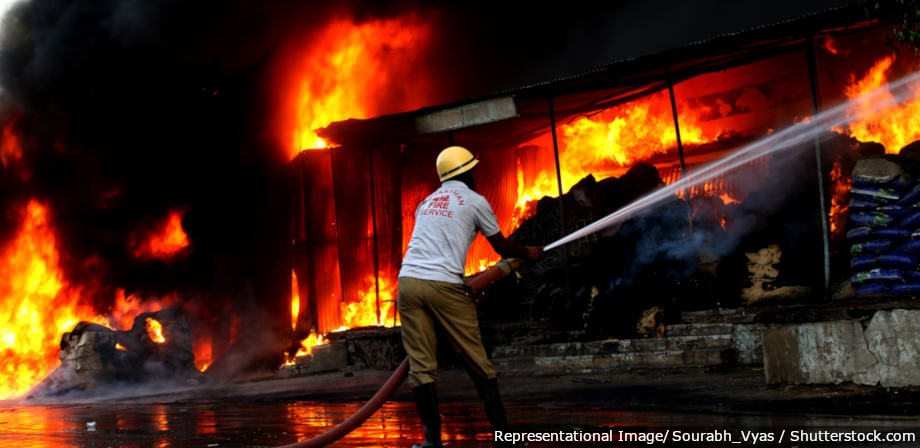India's Fire Preparedness: A FactCheck

Mumbai: As India deals with another fire tragedy, in which 40 people were killed at a paper factory in a residential area on Delhi's Rani Jhansi road on December 8, 2019, an analysis of government data shows that emergency fire services have a 90% shortage of staff, a 78% shortage of fire fighting equipment or vehicles, and a 61% shortage of fire stations, as against a 2012 requirement.
India had 46 reported deaths due to fire accidents every day in 2016, the highest in residential areas (50%) but buildings often do not follow fire safety standards leaving them susceptible to fires, according to experts and an analysis of the latest available data from the National Crime Records Bureau (NCRB).
"The fire services are not well organized in India," according to the website of the Directorate General of Fire Services. "In recent years, the requirements for fire safety cover have increased manifold whereas the development of fire service has not made much headway."
As many as 16,695 cases of fire accidents were reported across India in 2016, which caused 16,900 deaths and 998 injuries, NCRB data show.
The major reason of accidental fires was bursting of cooking gas cylinders or stoves (22%), followed by electrical short-circuits (16%), data show. The fire in Delhi was reportedly due to a short circuit in the electric meter of the factory where 200 workers were sleeping, but fire department experts are yet to ascertain the cause of the fire, officials told Factchecker.in.
Many people lost their lives because the factory, illegally running in a residential area, did not have enough ventilation or an evacuation route and plan, The Indian Express reported.
"If factories are allowed to operate legally or illegally in residential areas, then these kinds of incidents can't be ruled out and the fire brigade will find it difficult to reach the area," said G.C. Mishra, former director of the Delhi Fire Service.
The fire department faced three main problems in this case: First, the narrow road made it difficult to take vehicles and equipment inside and fire officers had to carry some equipment manually; there were inflammable materials packed near the only entrance to the building, and a lack of information on the details of the site, Atul Garg, director of the Delhi Fire Service told Factchecker.in. The fire department came prepared to fight a residential fire, but realised that it was a factory with many people trapped inside. "There was a delay due to wrong information and lack of vehicle mobility there," Garg said.
Buildings break norms
In most fires, "many people die due to smoke and less due to fire. So to prevent that you need to have a proper evacuation plan," M V Deshmukh, director of government affairs at Fire Safe India Foundation and a former fire adviser to the government of Maharashtra had told IndiaSpend, on the issue of structural collapse and fire safety in Mumbai, in July 2019.
The National Building Code lays down several provisions that help protect buildings from fires and enable easy evacuation. Tightly-packed buildings which break the code hinder rescue services as fire truck arms and hydraulic jacks have no space to move, Deshmukh said, giving the example of tall 100-150 metre towers that leave no space around and have only one lane going up to the building.
Fire stations have only 10% of required staff
Fire services are facing a 90% (503,365) shortage of manpower across the country, the home ministry said in a reply to the Rajya Sabha (upper house of parliament) on June 26, 2019. No more than 54,239 fire personnel worked across the country, against the required 557,123, as on December 31, 2018.
The government's estimated requirement of fire services is based on a 2012 report by Risk Management Solutions Inc., a consulting firm. Fire services are the municipal government's responsibility under Indian law.
Of 8,559 fire stations required, there are only 3,377 (39%) in India. There is also a 78% shortage of fire fighting equipment or vehicles in fire stations across states, as per Rajya Sabha data.
Even though the 13th Finance Commission (2010-2015) report pointed out the "dismal state" of fire services across the country, highlighting shortages in fire stations (97%), fire fighting and rescue vehicles (80%) and fire personnel (96%), there was little progress.
"There is always around 40% vacancy in the fire brigade team but that doesn't affect the performance of the people involved," Mishra, the former director of the Delhi Fire Services said. "Maybe the number of vehicles sent is lesser and it creates work pressure on the existing firefighters, but they still manage to perform well. Performing on the rescue ground is all about the spirit they have and it has nothing to do with manpower."
Source: Rajya Sabha; Note: Available data as of December 31, 2018, Requirement as per RMSI Report, 2012;
Note: Tripura has more manpower than required, Odisha has more fire stations than required, Chandigarh, Goa and Daman & Diu have more firefighting equipment/vehicles than required.
In cases where victims with burns are rescued, their care is often inadequate. For the millions of burn victims, there are just 1,339 beds at 67 centres (hospitals with dedicated burn-care units), according to data compiled in 2016 by the National Academy of Burns-India (NABI), along with a shortage of trained staff, as IndiaSpend reported in November 2019.
We welcome feedback. Please write to respond@indiaspend.org. We reserve the right to edit responses for language and grammar.


